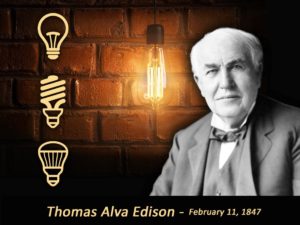Sign up for our newsletter
The books
This methodology with 24 steps and 15 tactics was created at MIT to help you translate your technology or idea into innovative new products. The books were designed for first-time and repeat entrepreneurs so that they can build great ventures.

Part 3 of 3—Creative Problem-Solving and Guerilla Skills
“One day I learned that dreams exist to come true. And since that day I do not sleep for rest. I sleep just to dream.”
“Restlessness is discontent and discontent is the first necessity of progress. Show me a thoroughly satisfied man and I will show you a failure.”
 Thomas Edison and Walt Disney are not just America’s greatest creative problem-solvers. They are paragons of all the antifragile entrepreneurial skills we have discussed. Edison is famous for the thousands of “failures” it took to come up with the right filament for his lightbulb. Disney’s businesses failed several times, and he almost went bankrupt in the midst of creating two of his many masterpieces – the film “Snow White” and Disneyland. Indeed, it was only after he lost his first character, Oswald the Lucky Rabbit, to unscrupulous producers that he came up with what would eventually be one of the world’s most recognizable corporate symbols and a cultural icon – Mickey Mouse.
Thomas Edison and Walt Disney are not just America’s greatest creative problem-solvers. They are paragons of all the antifragile entrepreneurial skills we have discussed. Edison is famous for the thousands of “failures” it took to come up with the right filament for his lightbulb. Disney’s businesses failed several times, and he almost went bankrupt in the midst of creating two of his many masterpieces – the film “Snow White” and Disneyland. Indeed, it was only after he lost his first character, Oswald the Lucky Rabbit, to unscrupulous producers that he came up with what would eventually be one of the world’s most recognizable corporate symbols and a cultural icon – Mickey Mouse.
Besides being perfect examples of perseverance, courage, confidence, and leadership, it is important to realize that their curiosity and creativity were not just about finding things to fix – problem-solving. Walt and Tom were especially ingenious at filling needs that had yet to be articulated. There was no such thing as a theme park or any of the many thousands of components that would go into it before Walt figured that families needed a fun way to do things together. Likewise, the “kinetographic camera” and phonograph were examples more of “creative opportunity-grabbing.” Even if you are not creating something revolutionary, though, your creative efforts will be more about improving than fixing.
Remember Bill Aulet’s bullseye description of antifragile entrepreneurs? People who, “grow when exposed to volatility, randomness, disorder, and stressors, and love adventure, risk, and uncertainty.” That description is never more so than when it comes to the creative process. Indeed, the skills are a step up because they aren’t just about weathering the storm and growing from adversity. When you set out to create something out of nothing, or just to improve or fix something, you are taking on the forces of chaos. No roadmap here, folks. But, hey, you love adventure, risk, and uncertainty, right?
There isn’t a roadmap, but there is improvisation – the “unforeseen.” The famed Chicago advertising agency Leo Burnett would not only pay for their creative staff to attend Second City’s improv school but would shell out for their client-service and media folks, too. They knew it wasn’t just about being better presenters, and they weren’t really interested in a bunch of comics hanging around the water cooler. They recognized early on the benefit of all the skills discussed in the previous pieces as well as collaboration, dealing with ambiguity, rewriting the rules, and just basic curiosity – the elements of creative pursuits.
Brainstorming
“I dream, I test my dreams against my beliefs, I dare to take risks, and I execute my vision to make those dreams come true.”
“To have a great idea, have a lot of them.”
 As we have emphasized before, entrepreneurs, possibly against what they suppose is their better judgment, must collaborate. Edison led teams of the finest minds he could find. Disney hand-picked employees from his studio to work on Disneyland and gave them an enviable handle, Imagineers, possibly the largest band of brainstormers ever. These two quotes define the difference in creative problem solving and just problem-solving. This is not logical trial and error, which is just a nice way of saying beat your head against the wall. Gather up as many ideas from various people and perspectives as you can; discuss them and filter them in a positive way, and try them out.
As we have emphasized before, entrepreneurs, possibly against what they suppose is their better judgment, must collaborate. Edison led teams of the finest minds he could find. Disney hand-picked employees from his studio to work on Disneyland and gave them an enviable handle, Imagineers, possibly the largest band of brainstormers ever. These two quotes define the difference in creative problem solving and just problem-solving. This is not logical trial and error, which is just a nice way of saying beat your head against the wall. Gather up as many ideas from various people and perspectives as you can; discuss them and filter them in a positive way, and try them out.
Remember our paragon of creative opportunity-grabbing, the improv troupe? They hone their brainstorming skills into a few seconds of tossing around ideas to meet their audience’s suggestions and expectations. To do that, they must follow some of the same methods of brainstorming we teach at Serious Improv!: no fearing failure; trust each other; be positive; no bad ideas; listen before talking.
 Nobody wants to come up with bad ideas, of course, but that unwillingness “to go bad, go silly, go stupid, go goofy” also can keep you from coming up with good ideas, or maybe a small part of a great idea. So, we have our improvisers stand in a circle and develop one by one an idea for the worst movie ever made. They start with combining two unlikely genres – say, documentary and slasher – then move on to the plot, characters, actors and eventually a really bad title. That’s actually easier than the next exercise where, in groups of three, they state a problem (possibly a real one that is affecting their work environment); then state a really ridiculous solution to the problem; then explain how the ridiculous solution could lead to a real solution. So, if the problem is that people are spending too much time playing internet games, the ridiculous solution is to provide free pop-tarts for everyone. The third person, then, suggests free breakfasts, including pop-tarts, to those who pledge they will only play games on their breaks, or not at all.
Nobody wants to come up with bad ideas, of course, but that unwillingness “to go bad, go silly, go stupid, go goofy” also can keep you from coming up with good ideas, or maybe a small part of a great idea. So, we have our improvisers stand in a circle and develop one by one an idea for the worst movie ever made. They start with combining two unlikely genres – say, documentary and slasher – then move on to the plot, characters, actors and eventually a really bad title. That’s actually easier than the next exercise where, in groups of three, they state a problem (possibly a real one that is affecting their work environment); then state a really ridiculous solution to the problem; then explain how the ridiculous solution could lead to a real solution. So, if the problem is that people are spending too much time playing internet games, the ridiculous solution is to provide free pop-tarts for everyone. The third person, then, suggests free breakfasts, including pop-tarts, to those who pledge they will only play games on their breaks, or not at all.
Those “bad ideas” teach improvisers to have the courage to speak up, and to not prejudge or post-judge ideas, and to deal with “volatility, randomness, and disorder.” At Serious Improv! we then move them on to more constructive brainstorming activities, such as inventing a ride for Disneyland. In small groups, they must not only work together to come up with a name and a detailed explanation of the ride, but they must also report on all the ideas they tossed out, or changes to those ideas, to reach their presentable idea. To teach them to deal with the real world of fickle clients, we sometimes change the marching orders halfway through, so that they must theme their ride around one or more princesses, or a villain. They then must report on how they adapted their old idea to these new parameters, or how they had to junk their original idea altogether.
Then, if they did a great job, they are rewarded with the opportunity of changing that really bad slasher documentary movie they came up with the circle to a really cool movie idea. They must keep as much of the original idea as they can. Interestingly, brainstormers do better with a little instruction or obstructions. Nothing is so daunting to the imagination as “blue sky,” or no restrictions. Often, groups struggling to come up with a good idea for a Disneyland ride will welcome the restriction of making it about princesses or another specific character. The lesson for creative problem-solving is to sometimes impose artificial restrictions to help foster ideas.
Rewriting the Rules
“Hell, there are no rules here – we’re trying to accomplish something.”
 What is especially endearing about this quote is Edison’s attitude, as if it is obvious that rules are antithetical to invention. And, to be sure, to the antifragile entrepreneurial improviser, they are. Rules, along with status quo, ennui, prejudice, dogma, routines, doubts, habits, certainties, fears, and any number of beliefs are the mental blocks between you and the solution/invention/idea you are seeking.
What is especially endearing about this quote is Edison’s attitude, as if it is obvious that rules are antithetical to invention. And, to be sure, to the antifragile entrepreneurial improviser, they are. Rules, along with status quo, ennui, prejudice, dogma, routines, doubts, habits, certainties, fears, and any number of beliefs are the mental blocks between you and the solution/invention/idea you are seeking.
We discussed many of the exercises that help our improvisers overcome their need for rules, etc., in the section on flexibility, which is vital to all improvising. Also, though, is the need to address these mental blocks “head-on” in order to dismantle them. Students in a circle can reveal their pet peeves, which are often rooted in prejudices. They can then talk about “other people’s prejudices” that they have witnessed. Then, perhaps in smaller groups, they can discuss their own habits, or even ruts, that they find themselves in.
Creative people are usually “zaggers,” which is to say, “when everyone else zigs, you zag.” Some zaggers are helped along by an honest discomfort with “trendy” “popular,” or anything involving conformity. We help them along in their zagging by encouraging them to take a different route to work every day, just to open their eyes and to get out of that “route routine.” We also reveal to them that they witness the world at their own height. To open their eyes, we have them stand on a table and/or lie on the floor.
A couple of “zagger” games are especially fun for the improvisers. In order to be “big picture” thinkers, they need to understand when the rules truly don’t apply. So, a “would you rather” game comes in handy, where the participants must think up scenarios in which the question is to follow a certain rule or, better yet, law, or break it in the name of some greater good.
To realize how we are manipulated by movies and media into certain emotional reactions, we use roleplay games where we are put into a cliché scene. We must first play the cliché emotional reaction, then play an opposite reaction. So, when our wife reveals she has driven the car into the swimming pool, first we get angry, then we suggest we leave it there and let the kids swim around it like it is a sunken treasure. In a favorite improv scene, when our kid reveals he is running away from home, we either ask to come along; offer to send some postcards along with him; ask him to drop off that electric screwdriver borrowed from Uncle Ed; or, ad infinitum. Because one of the biggest mental blocks concerns self-image, another fun exercise has us make up parts of our own body that we hate, and explain why. “I have the ugliest toenails. I wear my socks in the swimming pool I am so ashamed.” “Yeah, I know what you mean. The cuticles on my thumbs are so embarrassing, I can’t shake hands with anyone.” “I have too many bumps on my tongue. See?” “I don’t have any hair on my leg where my tights rub them. See?”
Getting Curiouser and Curiouser
“We keep moving forward, opening new doors, and doing new things, because we’re curious and curiosity keeps leading us down new paths.” — Walt Disney
 We have been working our way backward through the “creative process,” to the root of all intelligence, learning, and achievement – curiosity. Some of the previous exercises and games – those designed to open your eyes – can help teach curiosity. Or, rather, inspire it; there is no teaching curiosity. You follow the example of Edison’s mother and send your charge down to the basement with a chemistry set, and see what happens.
We have been working our way backward through the “creative process,” to the root of all intelligence, learning, and achievement – curiosity. Some of the previous exercises and games – those designed to open your eyes – can help teach curiosity. Or, rather, inspire it; there is no teaching curiosity. You follow the example of Edison’s mother and send your charge down to the basement with a chemistry set, and see what happens.
We encourage awareness to our environments; to all kinds of spatial, temporal, behavioral patterns; to methods of observing that which you have seen but not really seen. For instance, students are shown a variety of optical illusions. They must then see, for instance, both the faces looking at each other and the champagne goblet, in that popular illusion. They must be able to go back and forth in an optical illusion to see first one thing and then the other. They can then help others in the class who can’t quite see it.
One favorite is the color game, which we use virtually every day to keep ourselves sharp. It is as simple as closing our eyes, thinking of a color, and then opening our eyes. Amazingly, with little concentration needed, we will see that color in things we never saw before. Besides making us more observant, this exercise is parallel to a method of creative problem-solving: going from a part to the whole. So, if you have to come up with a Disneyland ride about villains, you may want to first come up with villainous characteristics, or, jump ahead to “scary,” and list all of the things that scare you. Then you can either match that too scary things in Disney movies or have the villains do those scary things to your riders, or….
Discover, Explore, and Heighten
“It’s kind of fun to do the impossible.” — Walt Disney
At a point in “Prisoner of Azkaban,” Harry Potter saves his godfather, Sirius Black by finally conjuring the very difficult Patronus charm. Afterward, he confides in Hermione that, because of their time traveling, he knew he could do the charm because he had already done it. And that is the charm in Walt’s quote. He could regard several “impossible” achievements and, maybe once they were accomplished, describe them as fun.
There is one impossible exercise left, impossible because it teaches virtually every antifragile entrepreneurial skill there is. It is called “Discover, Explore and Heighten.” Improv troupes use it to practice their “where,” or being able to visualize a scene out of an empty stage. So, if by their suggestions, the audience has placed me in an elevator, I must first decide the basics of this elevator – what kind of building is it in; is it old-fashioned, glass-walled, super fast? I then can focus in on specific aspects of it: the number of buttons; is the number thirteen missing; is the door not closing, or not opening. All of these specificities, you can see, have many possibilities for a skit or a story. I heighten them by choosing my relationship with any one or all of them. So, I discover that indeed there is no thirteenth floor even though my room number is 1313. So, if there is no 1313, then where did I sleep last night? Well, that accounts for the guy in the other bed snoring all night.
At Serious Improv!, we put you in “a space” and let you tell us what is there. If you are not specific enough, if you haven’t “discovered, explored and heightened” or just “discovered and explored” enough, we will ask you questions to prompt you. Besides opening your eyes, this exercise lets you leverage the most important resource you have – your imagination. Then, once you master this, you can create your own space. One fun exercise is for everyone to mime (maybe with sound effects) the one perfect room in their house, with that one special item that they wish they had. The rest of the audience can play along by guessing what the item is.
The Future
“There’s a way to do it better – find it.” — Thomas Edison
We always ask our students what they have learned. What you may have learned here is the inclination to detect the things in your life that don’t work right the things that annoy you; the things that can be improved; the services, situations, and things that you can possibly move from chaos to order. That is creative problem solving and creative opportunity grabbing. Miscellaneously worthy to note, successful creative antifragile entrepreneurs: rarely do it just for the money; look for best practices; drill down to essences; go wide and go deep in their interests; love change; respond well to pressure, and sometimes even need it; also respond well to the pure calm of a shower, looking at clouds or performing mindless tasks; understand that everything is inherently interesting… to somebody. Oh, and embrace surprise.
And (to bring it back around to the beginning of this series) they don’t give up.
“You may not realize it when it happens, but a kick in the teeth may be the best thing in the world for you.”
“Many of life’s failures are people who did not realize how close they were to success when they gave up.”
“All our dreams can come true if we have the courage to pursue them.”
Mike & Nate at Serious Improv
The authors
Mike Grimshaw & Nate Lee
Mike and Nate's backgrounds cover an impressive array of domains, from founding startups and angel investing, to sales, leadership & management training, advertising, financial strategy, customer engagement, and more. Together, they founded Serious Improv, where they use improv to help businesses and organizations improve the way they work .

The Disciplined Entrepreneurship Toolbox
Stay ahead by using the 24 steps together with your team, mentors, and investors.
How relevant was this article to you?
Click on a star to rate it!
Average rating 4.4 / 5. Vote count: 7
No votes so far! Be the first to rate this post.
We are sorry that this article was not useful for you!
Let us improve this post!
Tell us how we can improve this post?
